
|
Work is only one aspect of a person's life, but it's one of the big ones. Oftentimes, people get caught up with their jobs, impeding on their ability to appreciate the other parts of life that they deserve to enjoy. This is where the work-life balance comes into play – achieving equilibrium on a day-to-day basis is vital for our well-being as a whole.
We've surveyed 1,010 people working in the U.S. to learn more about their own work-life balance. What factors do they think are critical in order to achieve a healthy one? How has the COVID-19 pandemic affected people's balances? Do companies do all they can to help their employees achieve a healthy balance? Respondents also self-assessed to determine whether they had good or poor work-life balances. Read on to learn more about the findings.
Not many people denied that achieving a harmonious work-life balance was important, and over 83% of respondents believed that they currently had one.
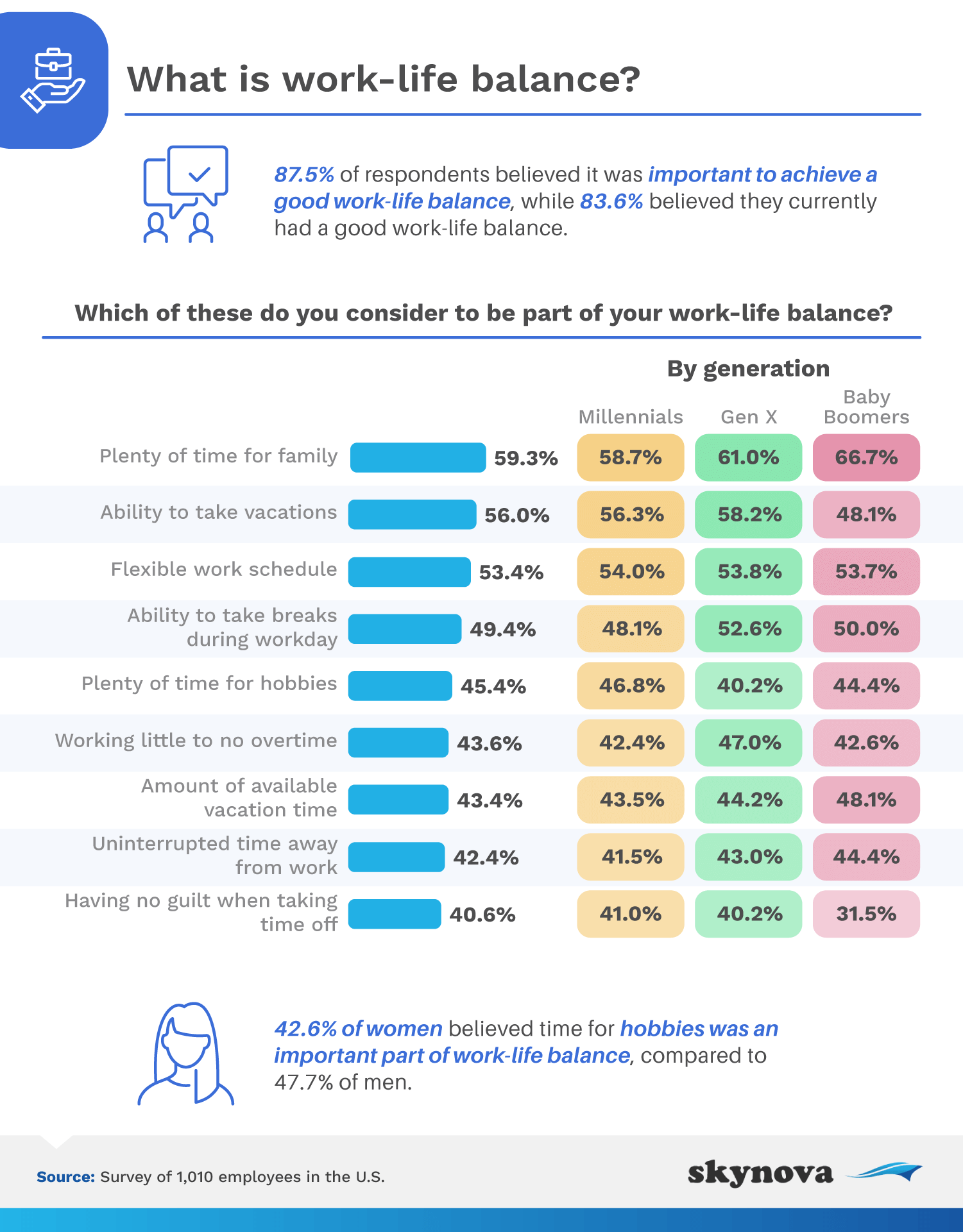
Among respondents, the most crucial aspect to a healthy work-life balance was ensuring they dedicated plenty of time to their family – baby boomers felt strongest about this. To decompress, 56% said the ability to take vacation time was important. Over half were also keen on having flexible work schedules.
Many considered intermittent breaks from work throughout their day; time to practice or enjoy their hobbies; avoiding working overtime; not being involved with work when away from it; and not feeling guilty about taking much needed breaks as key players in the hunt for the perfect work-life balance. If achieved, people would likely notice improvements in their mental health and well-being. On a business level, the benefits may include increased productivity, a jump in staff morale, and better customer service, to name a few.
Next, we asked respondents to compare their work-life balance from before the pandemic to now.
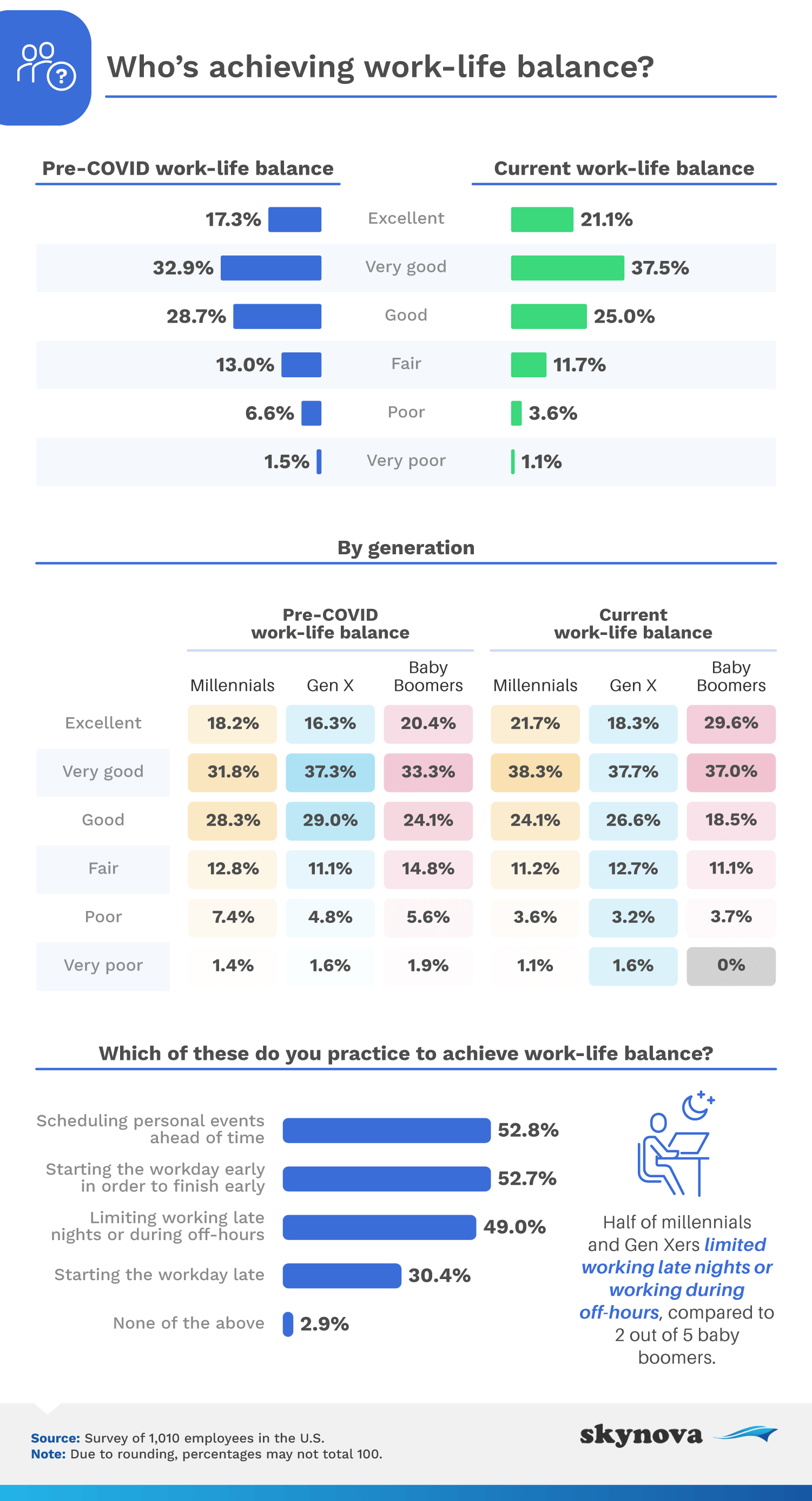
Before the pandemic, the majority of respondents would describe their work-life balances as good or very good. Although, 17.3% went as far to say it was excellent. When asked about their current work-life balance, people were even more optimistic about balancing their work and personal life. While there was a slight dip in the people responding with ‘good,' more of them said they've achieved very good or excellent balances. With many people working remotely now, it's possible that their home-based setups have contributed to the increased happiness in their work-life balance. For example, working from home means that people can manage their schedules much more freely, allowing them to tend to personal needs whenever they need to. It also eliminates the stress of commuting to work, saves money, and according to multiple studies, may increase productivity and performance.
To give themselves the best possible chance of achieving balance, over 50% of respondents made sure to schedule personal events well in advance and started their workday early in order to end early too. Just under half made it a point to limit how much they were working overtime. While half of millennials and Gen Xers followed this last rule, only 40% of baby boomers did.
Further, we asked respondents how their workplaces influenced their work-life balance and what perks they were looking for when accepting their current job.
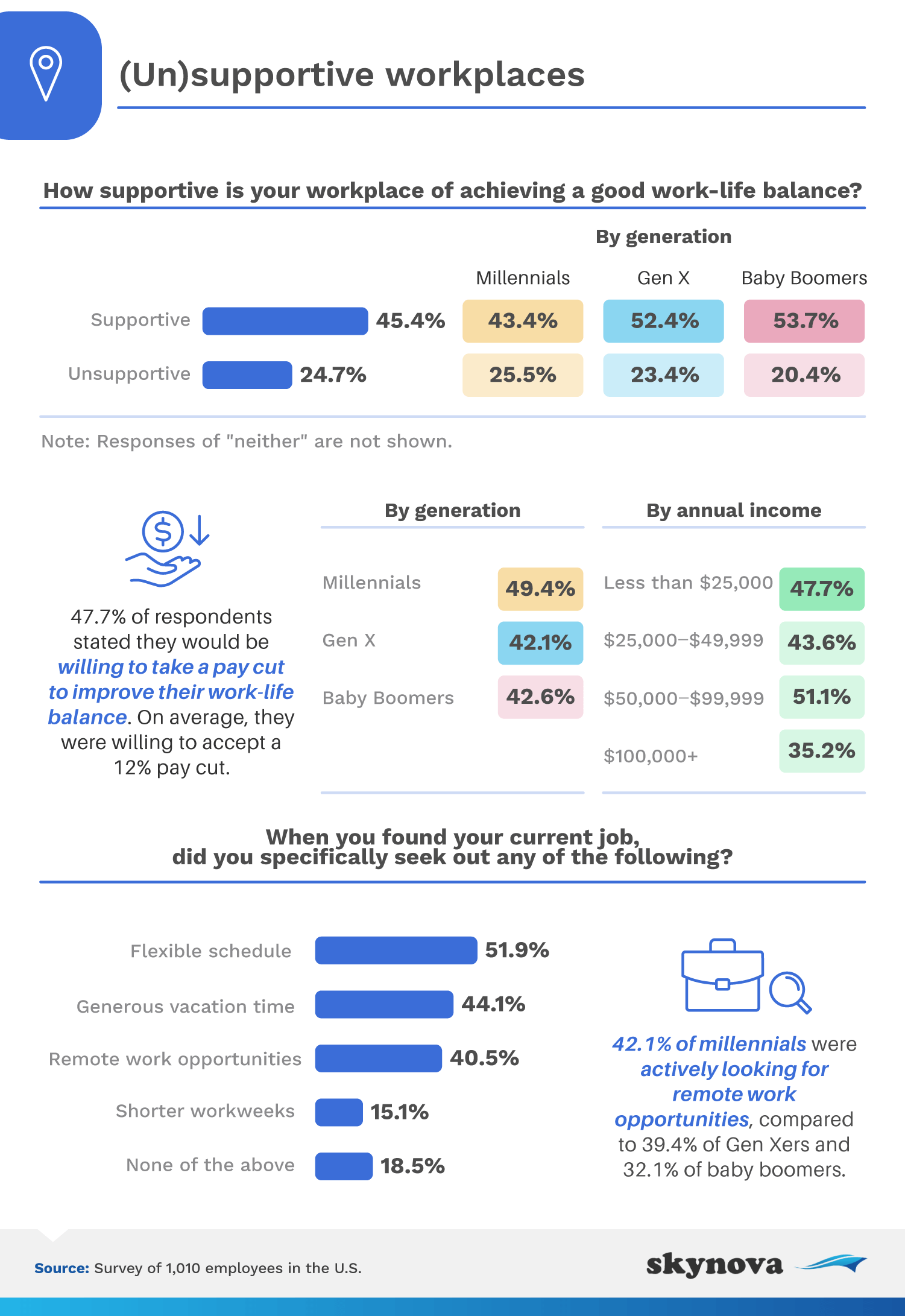
When asked if their workplaces were supportive of a positive work-life balance, nearly a quarter of respondents said they were not – millennials were most likely to agree with this sentiment. But would people be willing to take a pay cut if it meant achieving a better balance? Millennials were the most ready to sign on for a deal like this, but over 40% of Gen Xers and baby boomers were also interested. Also, over half of respondents making anywhere between $50,000 to $99,999 would be on board. On average, of the 47.7% willing to take a paycut, they would deduct 12% from their salary to improve their work-life balance.
To give themselves the best chance of achieving balance from the get-go, 51.9% of respondents emphasized the need for a flexible work schedule when they took their current job. Other common sought-out perks included a generous amount of vacation time and remote work opportunities, for which millennials were most actively looking out. Companies have started to realize the multiple benefits of working from home, and many are in the process of incorporating a long-term remote work solution to their business module. People won't have to look too far to find remote work if that's a priority for them.
Further, we looked at how the self-perceived work-life balance impacted various aspects of our respondents work performance and satisfaction.
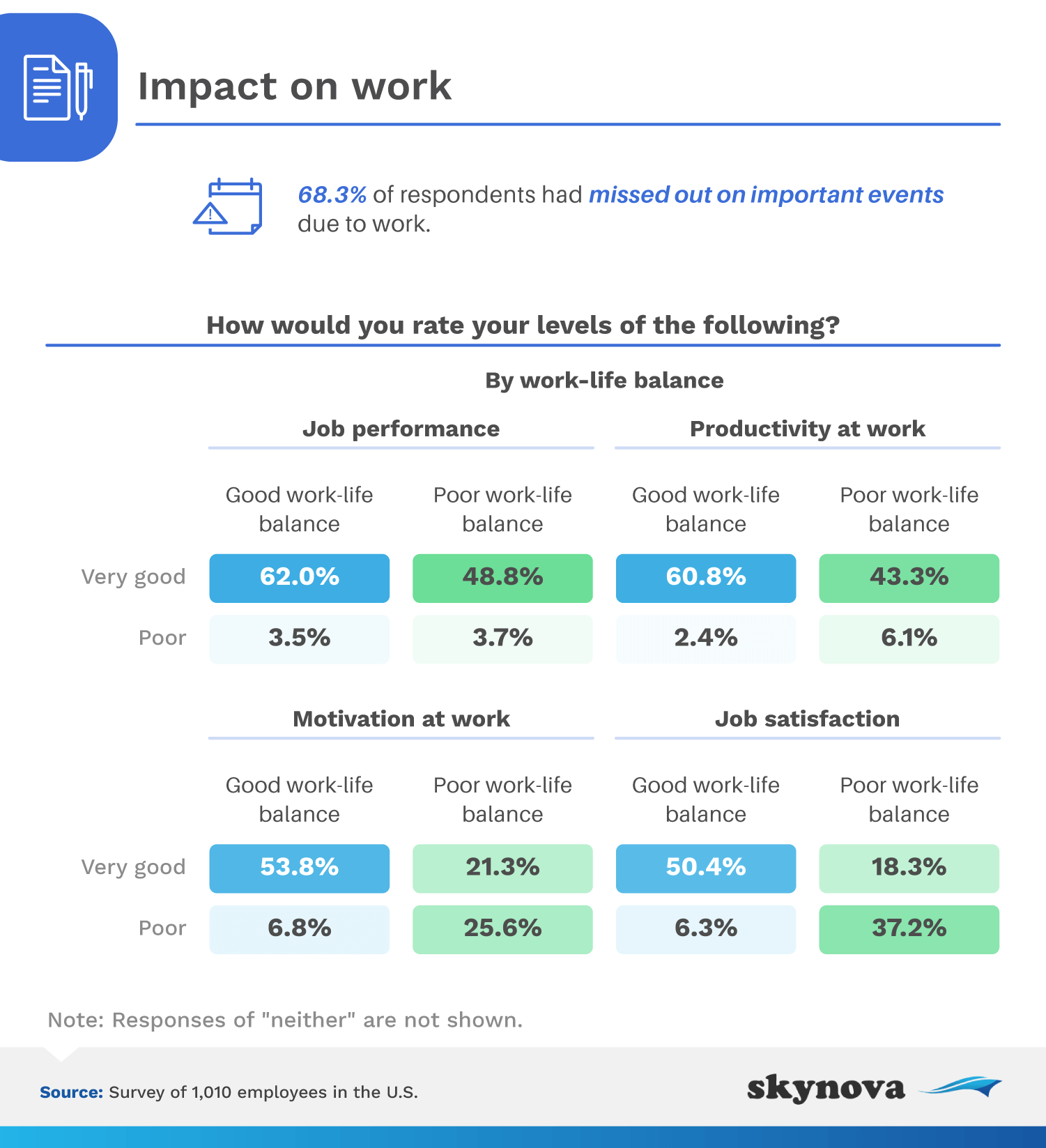
When we get wrapped up in our work, it can eat into our personal life – nearly 70% of respondents had missed out on an important non-work event because they were stuck at the office (or at home) working. Also, upon self-assessing whether they thought they had a good or poor work-life balance, people rated themselves based on four key components of work.
Across the board, people believing they had a good work-life balance rated their work experiences higher than those with a poor work-life balance. Regardless of self-assessment, very few thought they exhibited poor job performance and low productivity. That being said, a quarter of those with poor balance admitted they lacked motivation, and 37.2% had low job satisfaction. A work-life imbalance can be overwhelming and damaging to both your mental and physical health – eating healthy, exercising, getting enough rest, and relying on your support system or speaking to a professional can help alleviate stress and recalibrate your life for the better.
Lastly, we took a closer look at how self-reported work-life balance impacted the personal life of our respondents.
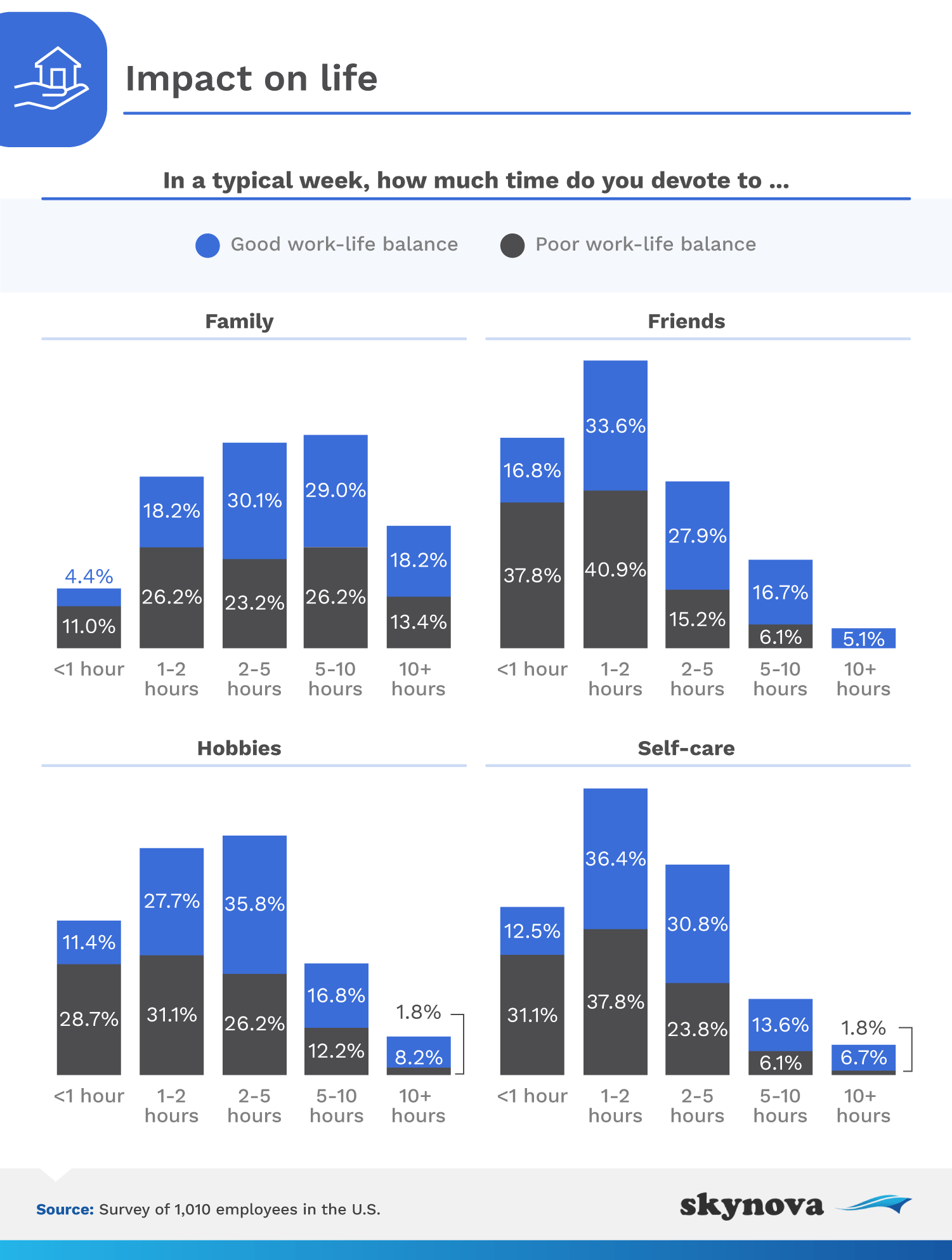
Using the same self-assessment answers, respondents were asked how much time they devoted to family, friends, hobbies, and self-care in a given week. Generally, people with poor work-life balances spent less time on all of these than those with good work-life balances – people who engaged in any of the activities for two or more hours per week identified as someone with good balance. Almost nobody who had poor balance spent more than 10 hours a week socializing with friends, enjoying their hobbies, or practicing self-care.
Some tips to improve your work-life balance have already been mentioned, but another big one to consider is setting limits for yourself. For example, it's important to practice time management to minimize the chance of overscheduling. Also, learn to say no – sometimes, we accept tasks out of guilt or a false sense of obligation, but getting out of that mindset is necessary for our own good.
Many believed in the importance of a harmonious work-life balance, and the most important non-work commitment was spending precious time with family members. Also, due to the pandemic, people's balances have actually gotten better – remote working presents a number of benefits to employees, such as being able to work in the comfort of their own home, subsequently eliminating the stress of commuting to an office or job site.
Only around 45% of respondents thought their workplace managers were supportive of helping them achieve a healthy work-life balance, and the most important perk sought when looking for a job was the ability to have a flexible schedule. Lastly, according to the self-assessments, people who had poor balances were much more likely to lack motivation at their job and generally be dissatisfied with it. They also spent less time tending to themselves, family, friends, and hobbies. Clearly, achieving a positive work-life balance can elevate many aspects of your life, not just the working one.
Skynova is a one-stop shop for all your online invoicing needs, helping small businesses manage their operations in a quick and organized fashion. On top of that, we like to produce in-depth articles about topics we are passionate about and hope you enjoy too. They usually take on a workplace/business angle, while incorporating another aspect of society (in this case, we've touched on work-life balance). To ensure our work is of the highest quality, we use both primary and secondary research to support our findings.
This study uses data from a survey of 1,010 employees located in the U.S. Survey respondents were presented with a series of questions, including attention-check and disqualification questions. 54.6% of respondents identified as men, while 45.4% identified as women. Respondents ranged in age from 19 to 71 with an average age of 36.9. 3.4% of respondents were Gen Zers, 63% were millennials, 25.1% identified as Gen Xers, and 8.5% reported as baby boomers. 15.2% of respondents had an annual income of $25,000 or less, 29.5% earned between $25,000 and $49,999 annually, 44.8% or respondents earned between $55,000 and $99,999 and 10.5% earned $100,000 or more annually. Participants incorrectly answering any attention-check question had their answers disqualified. This study has a 3% margin of error on a 95% confidence interval.
Please note that survey responses are self-reported and are subject to issues, such as exaggeration, recency bias, and telescoping.
If you know someone who could learn a thing or two about developing a healthy work-life balance, we encourage you to share these findings with them. We only ask that you do so for noncommercial use and to provide a link back to the original page for access to our full findings and methodologies.